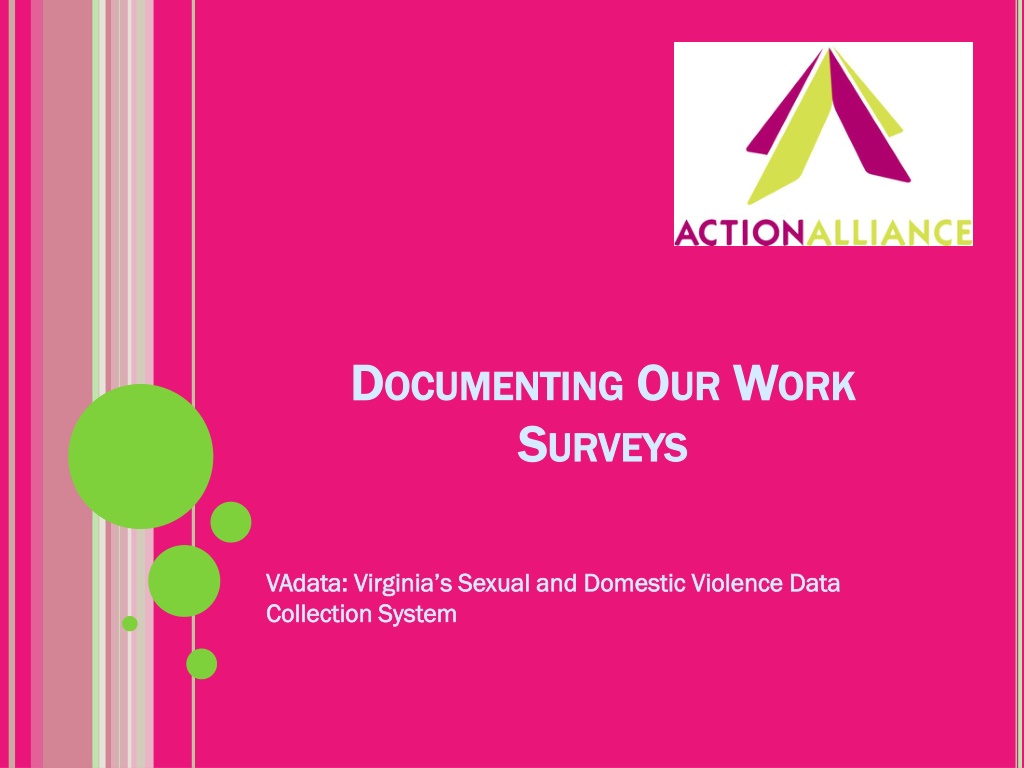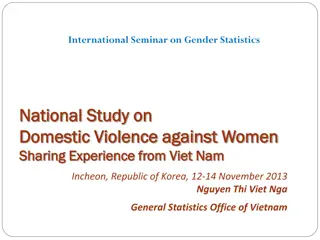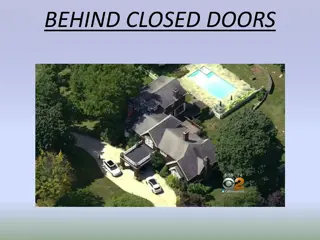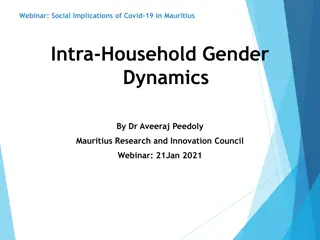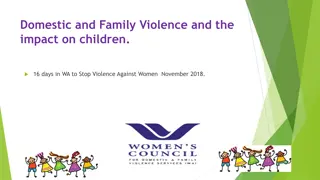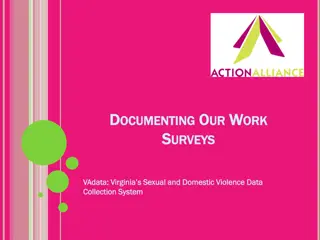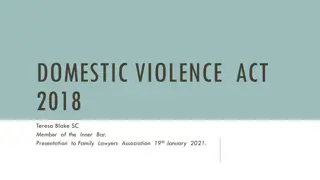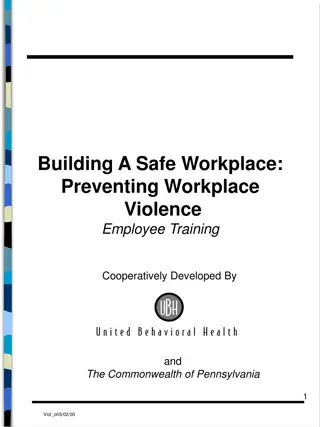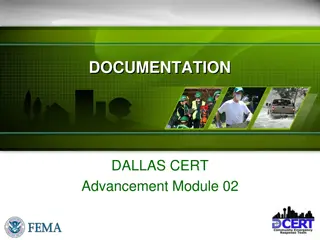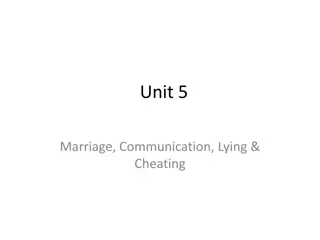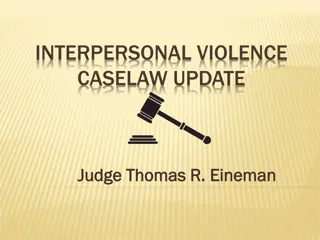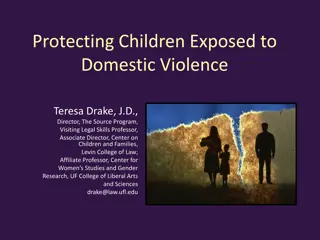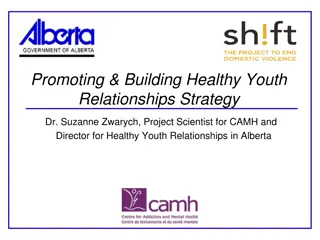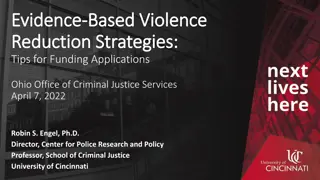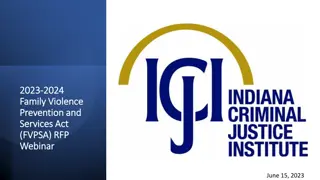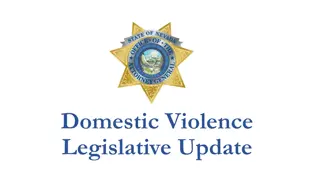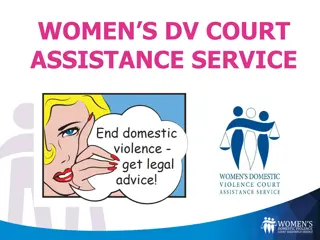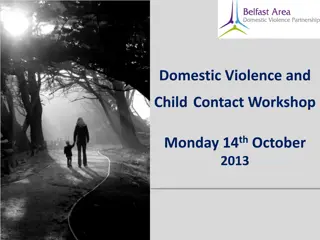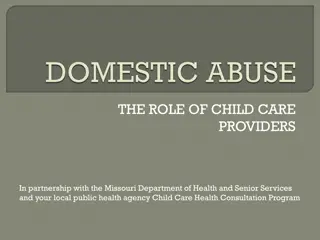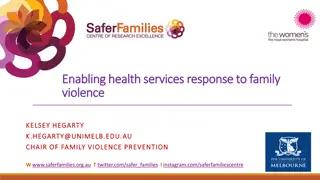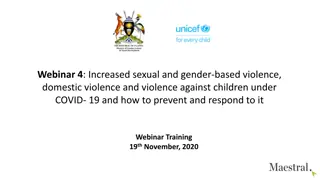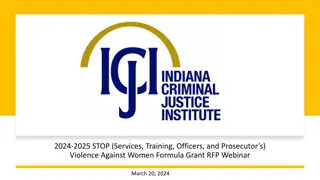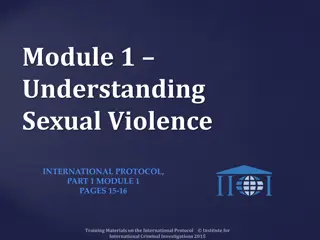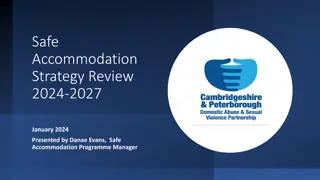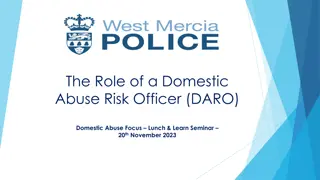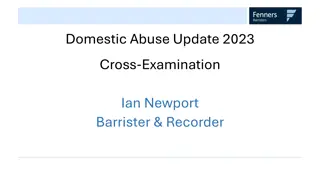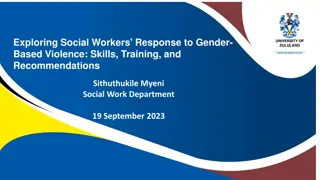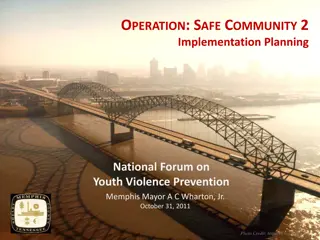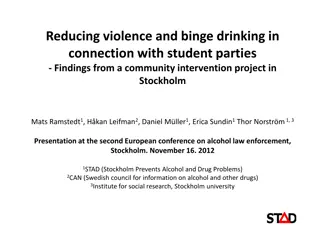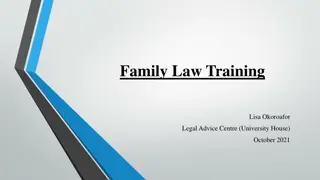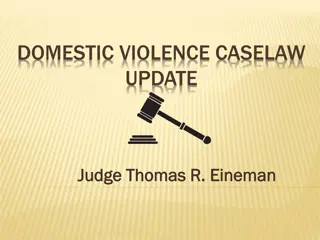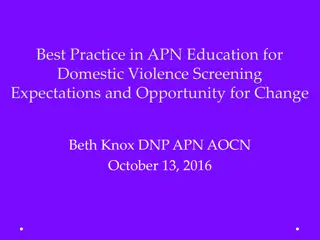Documenting Our Work: Virginia's Domestic Violence Data Collection System
The Documenting Our Work (DOW) project, initiated by the Family Violence Prevention and Services Act (FVPSA) staff, focuses on gathering outcome data to assess the impact of services by local domestic violence programs. Virginia's DOW surveys track specific outcomes, including safety strategies and community resource awareness, through two surveys completed by shelter residents and individuals accessing advocacy services. These surveys offer survivors a platform to share their experiences and identify the help they needed.
Download Presentation

Please find below an Image/Link to download the presentation.
The content on the website is provided AS IS for your information and personal use only. It may not be sold, licensed, or shared on other websites without obtaining consent from the author. Download presentation by click this link. If you encounter any issues during the download, it is possible that the publisher has removed the file from their server.
E N D
Presentation Transcript
D DOCUMENTING OCUMENTING O OUR S SURVEYS UR W WORK ORK URVEYS VAdata VAdata: Virginia s Sexual and Domestic Violence Data : Virginia s Sexual and Domestic Violence Data Collection System Collection System
DOCUMENTING OUR WORK The Documenting Our Work (DOW) project was initiated by Family Violence Prevention and Services Act (FVPSA) staff at the U.S. Department of Health and Human Services and the National Resource Center on Domestic Violence.
WHAT IS DOCUMENTING OUR WORK? Documenting Our Work is a national initiative to develop tools to gather outcome data on the impact and value of services provided by local domestic violence programs. It requires a specific type of data collection collecting data directly from adult survivors.
WHAT ARE OUTCOMES? Outcomes are the changes, benefits, learning or other effects that can happen as a result of services. Outcomes help document that services make a difference to and for survivors, and allow survivors to share about the impact of those services in their own words in their own words.
VIRGINIAS DOW SURVEYS TRACK THESE FVPSA OUTCOMES: As a result of contact with the domestic violence program: 1. Domestic violence survivors will have strategies for enhancing their safety strategies for enhancing their safety. 2. Domestic violence survivors will have knowledge of available community knowledge of available community resources resources.
THERE ARE 2 DOW SURVEYS: Community Community- -Based Services Based Services Survey Survey Shelter Resident Survey Shelter Resident Survey To be completed by people who are accessing shelter services. To be completed by people who are using other in-person advocacy services.
WHAT IS INCLUDED IN THE SURVEYS? The Shelter Resident Shelter Resident and Community Services Services surveys are essentially identical. Each survey: offers survivors the opportunity to identify help they needed and received (or did not), provides some outcome information about the impact of services on the survivor, and gives respondents the opportunity to share their thoughts about their experiences in their own words. Community- -Based Based
HOW DO CLIENT COMPLETE THE SURVEYS? Survivors can either complete the paper form the survey OR they can choose to complete it electronically. They should not be given both. Each agency has specific links to survey forms via our secure survey platform. Survivors can submit data anonymously using those links. See Module 14 Module 14 Documenting Our Work Online Documenting Our Work Online for more details. To obtain the links for your agency s surveys, please contact us at vadataadmin@vsdvalliance.org vadataadmin@vsdvalliance.org paper form of
PRINTING SURVEYS FROM VADATA Go to the VAdata Main Menu and click GO beside Forms, Printable in the VAdata VAdata Tools Tools section. Click on the survey that you want to download (Community-Based Services or Shelter Services). The survey will download automatically and you can print the .pdf form. Watch the how-to video by clicking here. (It's a bit dated but the instructions are the same. )
PRINTING SURVEYSFROM VADATA When you print your forms directly from VAdata, you ensure your agency s name agency s name and ID number and ID number are also included on the forms. This information is important to properly attribute the survey results to your agency when surveys are processed.
WHEN/HOW DO WE HAND OUTTHE SURVEYS? Community Community- -Based Services: Based Services: Give a survey to each adult adult who receives services from your agency on at least 3 different dates separated by a significant time period, such as every 6 8 weeks. Shelter Services: Shelter Services: Give a survey to residents at the point that you think they are about mid- way through their shelter stay, or as they are exiting from services. Do no distribute surveys to anyone under 18. Do no distribute surveys to anyone under 18.
WHATHAPPENS WHENA CLIENT COMPLETES A SURVEY? Some agencies request that people completing the surveys put them in a sealed envelope and return it to a staff person or provide a stamped and addressed envelope to mail it directly to the post office box. Some agencies choose to have a designated drop box or folder where survivors can anonymously drop off the surveys. All completed surveys should be sent to Action Alliance, PO Box 8565, Richmond VA 23226 PO Box 8565, Richmond VA 23226 on a regular basis (preferably weekly) and no later than 15 days following the end of a calendar quarter (Jan. 15, April 15, July 15, Oct. 15). PLEASE DO NOT MAIL SURVEYS TO THE A.A. PLEASE DO NOT MAIL SURVEYS TO THE A.A. OFFICE ADDRESS. OFFICE ADDRESS. Action Alliance,
WHAT HAPPENS WHENTHE ACTION ALLIANCE RECEIVESTHE SURVEYS? Action Alliance staff perform an initial quality control audit, then send the surveys to the Survey and Evaluation Research Lab (SERL) at VCU to enter the data. Summarized DOW data is provided via the DOW reports under the Reports for SDVAs and the VDSS Outcomes report. Paper surveys are shredded after they have been entered into VAdata, but a .pdf copy will be retained for quality assurance. Remember, due to our need to protect the privacy and anonymity of survey respondents, agencies are not able to see their specific responses until 90 days after the date see their specific responses until 90 days after the date surveys are coded into the system surveys are coded into the system. agencies are not able to
HOWWILLTHISDATABEHELPFUL? To improve services, including an examination of whether or not people from marginalized and/or underserved populations have different experiences with agencies, To document need and how agencies are or aren t able to meet those needs, and To promote accountability to the people we serve.
HOWWILLTHISDATABEHELPFULONA NATIONALLEVEL? These are outcomes that are valid, tested, and evidence-based, The outcomes and survey questions were informed by people working in the domestic violence field and not imposed by an outsider, Across the nation, survivors will be answering, at a minimum, these same two questions:
WILLTHEREBEOTHEROUTCOMES? All of this data can be used to document how people were helped as a result of services provided by your agency. There is also an opportunity for survivors to tell us what they would have done if your agency and services had not existed. In Virginia, this has provided some compelling qualitative data, all in a survivor s own words: Some responses to the question: What do you think you would have done if the Shelter did not exist? Stayed with the abuser I would have been killed or still in my situation I don t know. I think I would have took my life. Been on street; unsafe
QUESTIONS ABOUT DOCUMENTING OUR WORK: What happens if the surveys are not completed and/or returned? The surveys are completely VOLUNTARY. People may choose, for whatever reason, not to return or complete them. What is important is that everyone is offered the opportunity to share their voice. Incomplete surveys can still be submitted for data entry.
QUESTIONS (CONT.): What if someone leaves the shelter unexpectedly, without receiving a survey? This is going to happen, and it s not a problem. The goal is to develop a system for distributing the surveys and to follow your system whenever possible.
QUESTIONS (CONT.): What if an advocate forgets to give a person a survey on the planned date? This, too, is going to happen. When there are new procedures in practice and/or new staff and volunteers in the agency, things get missed. We encourage advocates to do what they can to assure that survivors are given the opportunity to participate. If the survivor has consented to receive electronic communication from your agency, it might be appropriate to provide them with a link to complete the survey electronically.
QUESTIONS (CONT.): Can or should we survey people more than once? If a person has received significantly different services from your agency, it is acceptable to survey them for the different engagements. significantly different If a person has received services from your agency for an extended period of time an extended period of time, it is okay to survey them more than once. It is suggested, however, not to survey them more than once in less than a 6-week period of time. We encourage advocates to do what they can to assure that survivors are given the opportunity to participate.
QUESTIONS (CONT.): Why do we need to download and print the surveys directly from VAdata? When surveys are downloaded directly from VAdata, it automatically supplies your program name and ID number at the top of the form on both sheets. If your survey doesn t include this information, we cannot link that data to your program and it won t be included in your reports. Downloading the surveys directly from VAdata also ensures that you are using the most up-to-date forms, meaning that you aren t losing any valuable outcome data and all survivors are answering the same questions statewide.
QUESTIONS (CONT.): Why does the look/quality of the survey matter? It is important to communicate to those we serve that their feedback is important to us. Providing survivors with a clean and legible survey conveys that we value their input. Surveys that look old (i.e. poor copies of copies, illegible print, copied sideways on the page, etc.) do not convey that. We understand that printing surveys in bulk is efficient, but please make sure that you don t compromise quality in the process.
H HELP ELP O OPTIONS PTIONS You may note this symbol by several fields You may note this symbol by several fields on the form: on the form: Click on the symbol for more detailed Click on the symbol for more detailed information or requirements of the information or requirements of the field. field.
HELP! VADATASNOTWORKING. If you think something is wrong with VAdata, please let us know! Give us a call at 804.377.0335 804.377.0335 OR email us at vadataadmin@vsdvalliance.org vadataadmin@vsdvalliance.org. . We don t use VAdata in the same ways you do, so sometimes the only way that we know something is off or broken is when you tell us. We also like to talk with you by phone when you have questions, because we usually want information that you might not know we need.
HOW CAN I GET ADDITIONAL HELP ABOUT OTHER TOPICSOR CONCERNS? The Action Alliance staff urge you to contact us whenever you have a question or a concern about VAdata, resources, advocacy, policy, training, funding, or anything else. Staff can be reached at 804.377.0335 804.377.0335 Or you can visit our website to send a message directly to staff members. Visit https://vsdvalliance.org/contact/.
